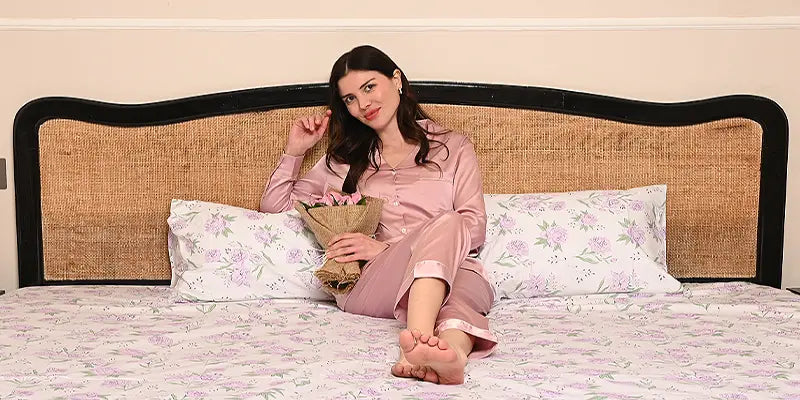
What is the Difference Between Nightwear and Sleepwear?
In India, most people think nightwear and sleepwear are the same thing and use the terms "nightwear" and "sleepwear" interchangeably. However, they can mean slightly different things depending on the context, style, and functionality. Now the question arises, what sets them apart? In this blog, we’ll explain what’s the difference between sleepwear and nightwear.
What is Nightwear?

Nightwear for women is a broader term that includes any clothing you wear during the evening or nighttime, not just for sleeping. It can be more versatile and stylish, often doubling as loungewear or even casual homewear. Nightwear can be worn while relaxing at home, reading a book, or enjoying a quiet evening.
Examples of Nightwear:
- Robes or dressing gowns
- Loungewear sets
- Silk slips or camisoles
- Fancy pajama sets (often with lace or satin details)
- Coordinated sets with matching accessories
Key Features of Nightwear:
- Can be made from a variety of fabrics, including luxurious materials like satin, silk, or velvet.
- Often more stylish and visually appealing than basic sleepwear.
- May include decorative elements like lace, embroidery, or ribbons.
- Can be worn for sleeping or lounging around the house.
What is Sleepwear?

Sleepwear refers to clothing specifically designed for sleeping. The primary purpose of sleepwear is to provide comfort, ease, and relaxation while you rest. It’s all about functionality and ensuring you get a good night’s sleep.
Examples of Sleepwear:
- Pajama sets (top and bottom)
- Nightgowns
- Sleep shirts
- Sleep shorts
- Onesies or footed pajamas
Key Features of Sleepwear:
- Made from soft, breathable fabrics like cotton, silk, or bamboo.
- Designed to be loose-fitting for maximum comfort.
- Often lightweight to prevent overheating during sleep.
- Focused on practicality rather than style.
Key Differences Between Sleepwear and Nightwear
|
Aspect |
Sleepwear |
Nightwear |
|
Purpose |
Designed specifically for sleeping. |
Can be worn for sleeping or lounging. |
|
Comfort Level |
Focuses on maximum comfort for sleep. |
Comfortable but may prioritize style. |
|
Fabrics |
Soft, breathable (e.g., cotton, bamboo). |
Can include fancier fabrics (e.g., silk, satin). |
|
Fit |
Loose-fitting or stretchy for easy movement. |
May be fitted or loose, depending on style. |
|
Design |
Simple, functional designs. |
Often more stylish and fashionable. |
|
Occasions |
Primarily for sleeping. |
Can be worn for sleep, lounging, or even as loungewear at home. |
|
Examples |
Pajama sets, nightgowns, onesies. |
Chemises, silk robes, fancy negligees. |
|
Durability |
Designed for frequent washing and long-term use. |
May require more delicate care due to fabrics. |
|
Seasonality |
Often designed for specific seasons (e.g., flannel for winter). |
May require more delicate care due to fabrics. |
|
Functionality |
Practical features like pockets or moisture-wicking. |
Focuses more on aesthetics than functionality. |
How to Choose Between Sleepwear and Nightwear
Your choice between sleepwear and womens nightwear depends on your needs and preferences. Here are some tips to help you decide:
- For Sleeping: Opt for sleepwear if your main goal is comfort and rest. Look for soft, breathable fabrics that help regulate your body temperature.
- For Lounging: Choose nightwear if you want something stylish to wear around the house. Nightwear can make you feel put-together even when you’re relaxing.
- For Special Occasions: If you’re looking for something romantic or elegant, nightwear with luxurious fabrics and designs is the way to go.
- For AllRound Use: Some pieces, like a cozy robe or a simple pajama set, can double as both sleepwear and nightwear.
Popular Fabrics for Sleepwear and Nightwear
|
Fabric |
Key Features |
Best For |
|
Cotton |
Soft, breathable, hypoallergenic, moisture-wicking |
All seasons, especially warm weather |
|
Silk |
Luxurious, smooth, lightweight, temperature-regulating |
Year-round, especially for a luxurious feel |
|
Bamboo |
Eco-friendly, soft, breathable, moisture-wicking, antibacterial |
Sensitive skin, eco-conscious shoppers |
|
Flannel |
Soft, warm, brushed texture (often cotton or wool) |
Winter sleepwear |
|
Linen |
Lightweight, breathable, moisture-wicking |
Summer sleepwear, hot sleepers |
|
Microfiber |
Soft, lightweight, durable, easy to care for |
Lightweight and cozy robes or loungewear |
|
Satin |
Smooth, glossy, lightweight (often polyester or silk blends) |
Sleek, elegant sleepwear |
|
Wool |
Warm, temperature-regulating, natural |
Cold-weather sleepwear |
|
Rayon |
Soft, lightweight, breathable, drapes well |
Lightweight and elegant nightgowns |
|
Polyester Blends |
Durable, wrinkle-resistant, affordable, often blended for softness |
Budget-friendly, low-maintenance sleepwear |
Conclusion
While nightwear and sleepwear may seem similar, the key difference lies in their purpose and style. Sleepwear is all about comfort and functionality for a good night’s sleep, while nightwear can be more versatile, stylish, and suitable for lounging or relaxing. Whether you prefer the simplicity of sleepwear or the elegance of girls nightwear, the most important thing is to choose something that makes you feel comfortable and confident.








